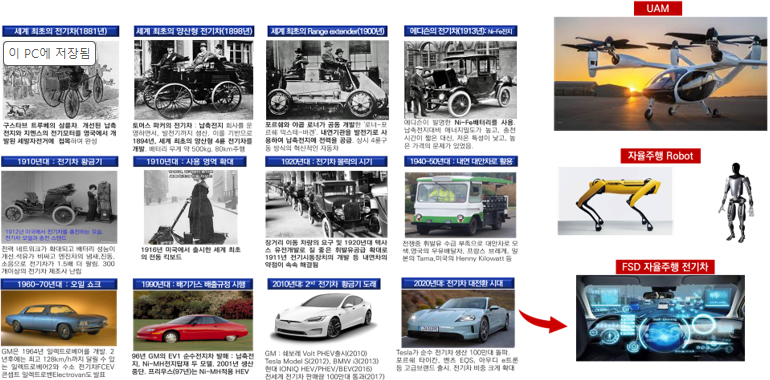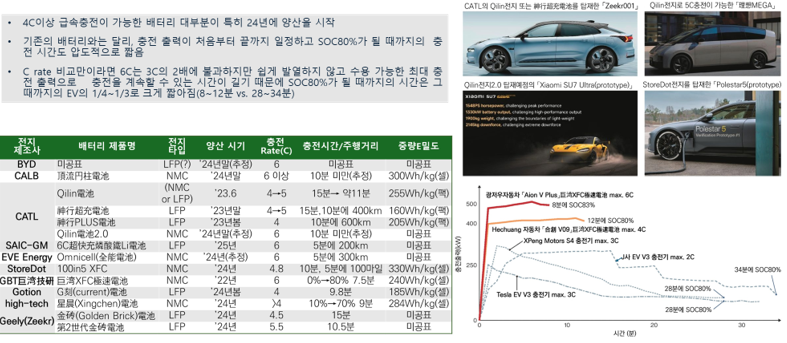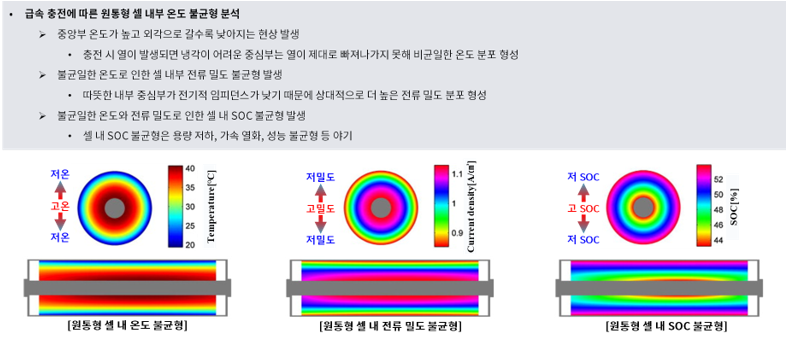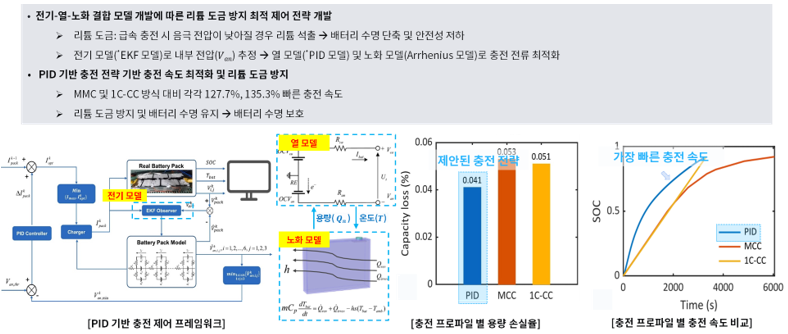<2025> Fast Charging Technology Trends and Outlook for Secondary Batteries
On April
21, 2025, CATL unveiled its 2nd-generation Shenxing battery at ‘Super Tech
Day.’ Based on LFP chemistry, the battery enables up to 520 km of driving on a
5-minute charge and can charge from 5% to 80% in just 15 minutes even at –10°C.
CATL announced plans to equip the battery in over 67 EV models within 2025.
In March
2025, BYD introduced its 10C flash-charging Blade Battery, capable of
delivering approximately 470 km of range with just a 5-minute charge. Utilizing
silicon carbide (SiC) power chips and BYD's proprietary Blade Battery, the
system supports charging at up to ~1000V and 1MW. BYD plans to build over 4,000
ultra-fast charging stations across China. The charging speed surpasses Tesla’s
Supercharger and reduces EV charging time to a level comparable to fueling
internal combustion engine vehicles.
The
ultra-fast charging technologies developed by CATL and BYD are expected to
address key concerns over EV charging time and driving range, thereby
accelerating EV adoption. These technological advancements pose a significant
challenge for battery manufacturers in the U.S. and Europe.
China,
which holds the world’s largest charging infrastructure, plans to build a
network capable of supporting over 20 million EVs by 2025. The country is
introducing various charging methods, including battery swapping stations. As
of October 2024, a total of 11.88 million chargers have been installed, of
which 3.39 million are public chargers.
As of the
end of 2024, approximately 200,000 public charging ports are in operation in
the United States. EVgo plans to install 7,500 fast chargers rated at 350 kW
over the next five years. Through technological standardization, Tesla’s NACS
(North American Charging Standard) plug has been adopted as an SAE
international standard, and major automakers are now adopting it.
The EU aims
to install 3.5 million public charging points by 2030 and has mandated the
installation of fast charging stations at 60 km intervals along highways. As of
the end of 2023, more than 630,000 public chargers had been installed, and
approximately 410,000 new chargers need to be added annually to meet the
target. CCS (Combined Charging System) has been adopted as the primary
technical standard, and the deployment of high-power fast charging stations
(HPC) is expanding.
Meanwhile,
South Korea aims to install 1.23 million chargers by 2030, including 12,000 DC
fast chargers by 2025. As of the end of 2022, approximately 200,000 public
chargers had been installed, one of the highest levels globally. DC fast
chargers account for about 13% of the total, and the deployment of high-power
chargers is expected to increase going forward.
Going
forward, fast charging technology is expected to converge with solid-state
batteries, hybrid battery systems, ultra-high voltage charging systems (800V
and above), and wireless charging technologies, forming a new paradigm. Fast
charging technology for secondary batteries is not merely about charging speed;
it represents an integration of battery materials, design, and system
integration technologies. It is expected to play a pivotal role in accelerating
the adoption of electric vehicles and enhancing the overall competitiveness of
the battery-based energy industry.
Cathode
materials for fast charging must withstand high current densities during rapid
charging. Therefore, high-nickel NCM/NCA materials with higher nickel content
than conventional NCM622 or NCM811 are mainly used. To control oxidation
reactions that occur during fast charging, surface coating technologies—such as
Zr-, Al-, or Ti-based coatings—are also applied.
For anode
materials, there is a risk of lithium plating during fast charging. To address
this issue, silicon-based composite anodes (such as SiOx or Si–C composites)
are gaining attention. However, improvements in binders and surface
modification techniques are also being implemented to mitigate
expansion-related challenges.
Meanwhile,
electrolytes require high ionic conductivity for effective fast charging. To
achieve this, technologies such as high-concentration electrolytes (HCE, LHCE)
and additives (e.g., FEC, VC) are used to control SEI formation and enhance the
thermal stability of the electrolyte.
In
electrode design and structure, thin electrode designs or three-dimensional
structured electrodes are being applied to shorten the diffusion path of
lithium ions within the electrode. Optimization of conductive additives is also
used to minimize internal resistance. These structural improvements contribute
not only to reducing charging time but also to suppressing heat generation.
Thermal
management systems, whose importance has grown recently, address heat issues at
the battery cell level. A variety of technologies are being implemented,
including PCM (phase change material)-based cooling, liquid cooling systems,
and AI-based temperature prediction and control systems.
As of 2024,
the global EV charger market is estimated at approximately USD 22.45 billion
and is expected to reach USD 257 billion by 2032, with a CAGR of around 35.6%
(Fortune Business Insights).
This report
broadly covers the current status of battery fast charging, fast charging
technologies and trends, application of fast charging systems, and the
development of next-generation fast charging technologies. It includes detailed
information from basic principles to practical applications, offering valuable
insights for understanding and learning technologies related to both batteries
and chargers in the field of fast charging.
The
strong points of this report are as follows:
① Latest trends in fast
charging infrastructure
②
Development status of major battery OEMs for fast charging
technology
③ Domestic
and international policy and standardization trends for fast charging
④
Fast charging systems for devices ranging from small
electronics to drones, UAM, autonomous robots, and EVs
⑤ Next-generation
charging technologies and research trends, including wireless fast charging for
batteries
<History and Future of EV Development (UAM, Autonomous EVs, Robots)>

<High C-rate batteries: Start of mass production of batteries capable of charging in under 10 minutes and launch of EVs equipped with them>

<Internal temperature
characteristics under fast charging – ① Cylindrical type>

<Optimization study of battery pack fast charging to prevent lithium plating>

Contents
1. Battery Fast Charging Infrastructure and Development Status
1.1
Current Status of Battery Fast Charging 11
1.1.1 Status
Surrounding Fast Charging Infrastructure 11
1.1.1.1 History of EV Development and Future
Directions 11
1.1.1.2 History of EV Development and Charger
Development 12
1.1.1.3 Comparison of Major Charging Technologies 13
1.1.1.4 Survey Analysis of Charging Environment in
Korea 14
1.1.1.5 Survey Analysis of Charging Environment in
China 16
1.1.1.6 Status of Vehicles Based on China’s High-Voltage Fast Charging Platform 18
1.1.1.7 Status of China’s
High-Voltage Fast Charging Infrastructure 19
1.1.1.8 China’s High-Voltage
Fast Charging Support Policies 20
1.1.1.9 Survey Analysis of Charging Infrastructure
in the US 21
1.1.2 Status Surrounding Fast Charging Technologies 22
1.1.2.1 Start of Mass Production of Batteries
Supporting Charging (<10 min) and Launch of EVs Equipped with Them 22
1.1.2.2 High C-rate Batteries: Major Manufacturers
Overview 23
1.1.2.3 CATL Qilin Battery 24
1.1.2.4 Summary of Characteristics of CATL
2nd-Generation Shenxing Battery 26
1.1.2.5 BYD’s Ultra-Fast
Charging Technology 30
1.1.2.6 巨湾技硏(GBT) XFC
Ultra-Fast Charging Battery Cell 31
1.1.2.7 巨湾技硏(GBT) XFC
Ultra-Fast Charging Battery Cell Roadmap 34
1.1.2.8 CATL Qilin Battery (Composite Current Collector:
MPCC) 35
1.1.2.9 Introduction of Porous Current
Collector (PCC) 36
1.1.2.10 High C-rate Batteries:
Application of Porous Current Collector (PCC) Sheet (Murata) 37
1.1.2.11 High C-rate Batteries:
Comparison of Fast Charging Batteries 38
1.1.2.12 BYD Ultra-Fast Battery
Technology 40
1.1.2.13 Ultra-Fast Charging Technology:
Emergence of 1MW Maximum Power 41
1.1.2.14 Status of Charging Services by
Major Countries 42
1.1.2.15 Global EV Charger Market Outlook
43
1.1.2.16 Status of Charging Services by
Major Countries: Japan 44
1.1.2.17 Beginning of Global Ultra-High Power Charging 48
1.1.2.18 Introduction of Ultra-High Power Chargers in Japan 49
1.1.2.19 DWPT Demonstration at
Osaka-Kansai Expo in Japan 50
1.2
Overview of Battery Charging Basics 53
1.2.1 Basic Structure
and Charging Principles of Lithium-Ion Batteries 53
1.2.1.1 Charging Principles of Lithium-Ion Batteries
53
1.2.2 Charging Methods of Lithium-Ion Batteries 54
1.2.2.1 Constant Current - Constant Voltage Charging
54
1.2.2.2 Multi-Stage Constant Current Charging 55
1.2.2.3 Constant Power - Constant Voltage Charging
56
1.2.2.4 Constant Temperature Constant Voltage
Charging 57
1.2.2.5 Boost Charging 58
1.3 Design of Battery
Fast Charging Technology 59
1.3.1 Overview of
Fast Charging Technology 59
1.3.1.1 Necessity of Battery Fast Charging 59
1.3.1.2 Issues from Applying Battery Fast Charging
61
1.3.2 Design Strategies for Fast Charging Technology
63
1.3.2.1 Considerations in Designing Battery Fast
Charging Strategies 63
1.3.2.2 Design Strategies for Battery Fast Charging
Profiles 64
1.4
Electrochemical Property Analysis Based on Battery Fast Charging 70
1.4.1 Changes in
Internal Properties by Material 70
1.4.1.1 Changes in Internal Properties Under Fast
Charging – (1) NMC 70
1.4.1.2 Changes in Internal Properties Under Fast
Charging – (2) LFP 71
1.4.1.3 Changes in Internal Properties Under Fast
Charging – (3) LTO 73
1.4.2 Changes in Internal Properties by Cell Format 74
1.4.2.1 Changes in Internal Temperature Properties
Under Fast Charging – (1) Cylindrical 74
1.4.2.2 Changes in Internal Temperature Properties
Under Fast Charging – (2) Pouch 76
1.4.2.3 Changes in Internal Temperature Properties
Under Fast Charging – (3) Prismatic 77
1.4.2.4 Battery Fast Charging Infrastructure and
System Requirements – Output 78
1.5
Requirements for Battery Fast Charging 79
1.5.1 Battery Fast
Charging Infrastructure and System Requirements 79
1.5.1.1 Infrastructure Expansion 79
1.5.1.2 Power 80
1.5.1.3 ESS 81
1.5.1.4 V2G 82
1.5.1.5 Communication Systems 83
1.5.1.6 Safety 84
1.5.1.7 Optimization of Charging Speed and Power
Consumption 85
2.
Battery Fast Charging Technology
2.1 Overview of
Battery Charging Technology 87
2.1.1 On-Board Battery Charging 87
2.1.1.1 Overview of On-Board Charging Technology 87
2.1.1.2 Structure of On-Board Charging Systems 89
2.1.1.3 Advantages and Disadvantages of On-Board
Charging Technology 91
2.1.2 Off-Board Battery Charging 92
2.1.2.1 Overview of Off-Board Charging Technology 92
2.1.2.2 Structure of Off-Board Charging Systems 94
2.1.2.3 Advantages and Disadvantages of Off-Board
Charging Technology 97
2.1.2.4 Application Cases of Off-Board Charging 98
2.2 Structure and Principles of Battery Charging Systems 100
2.2.1 Hardware Configuration and Structure of
On-Board Charging Systems 100
2.2.1.1 Overview of On-Board Charging Systems 100
2.2.1.2 Hardware Structure of On-Board Charging
Systems 101
2.2.2 Operating Principles of On-Board Charging
Systems 110
2.2.2.1 Operating Concepts of On-Board Charging
Systems 110
2.2.2.2 Protective Control Technology in On-Board
Charging Systems 112
2.2.3
Hardware Configuration and Structure of Off-Board Charging Systems 115
2.2.3.1 Overview of
Off-Board Charging Systems 115
2.2.3.2 Hardware Configuration of Off-Board Charging
Systems 116
2.2.3.3 Hardware Structure of Off-Board Charging
Systems 117
2.2.4 Operating Principles of Off-Board Charging Systems 124
2.2.4.1 Operating Concepts of Off-Board Charging
Systems 124
3.
Battery Fast Charging Technology Trends
3.1 Domestic and
Global Trends in Fast Charging Technology 130
3.1.1 Status of Domestic and Global Fast Charging
Market Infrastructure 130
3.1.1.1 Status of Domestic Fast Charging
Infrastructure 130
3.1.1.2 Status of Overseas Fast Charging
Infrastructure 131
3.1.2 Overview of Domestic and Global Fast Charging
Technologies 132
3.1.2.1 QC (Quick Charge) Technology 132
3.1.2.2 USB Power Delivery (USB PD) Charging
Technology 139
3.1.2.3 GaN (Gallium Nitride)-Based Charging
Technology 147
3.2
Domestic and Global Fast Charging Technology Policy and Standardization Trends
152
3.2.1 Necessity of
Fast Charging Infrastructure and Standardization 152
3.2.1.1 Necessity and Current Status of Expanding
Fast Charging Infrastructure 152
3.2.1.2 Necessity of Standardizing Fast Charging
Infrastructure 153
3.2.2 Domestic and Global Fast Charging Technology
Standards and Regulatory Trends 155
3.2.2.1 Introduction to Domestic and Global Fast
Charging Technology Standards 155
3.2.2.2 Application Trends of EV Fast Charging
Technology Standards 156
3.2.2.3 Status of Standards and Regulations for Fast
Chargers 160
3.2.3 Domestic and Global Policies and Support
Measures for Fast Charging Technology Development 163
3.2.3.1 Domestic Policies and Support Measures for
Fast Charging Technology Development 163
3.2.3.2 Overseas Policies and Support Measures for
Fast Charging Technology Development 164
3.2.4 Domestic and Global Fast Charging Technology
Patent Trends 167
3.2.4.1 Status of Domestic and Global Patent
Applications 167
3.2.4.2 Issues in Fast Charging Technology Patents
168
4.
Application of Battery Fast Charging Systems
4.1 Battery Fast
Charging Systems for Small Applications 170
4.1.1 Development of Charging Systems for Small
Applications 170
4.1.1.1 Overview and Development Background of Small
Applications 170
4.1.1.2 Advancement of Fast Charging Technologies
and Protocol Innovation 171
4.1.1.3 Optimization of Fast Charging Systems and
Technologies 173
4.1.1.4 Development of Technologies for Battery Life
Management and Safety Improvement 174
4.1.2 Structure and Application Cases of Fast
Chargers for Small Applications 175
4.1.2.1 Fast Charging Requirements for Small
Applications 175
4.1.2.2 Hardware of Fast Chargers for Small
Applications 176
4.1.2.3 Software of Fast Chargers for Small
Applications 177
4.1.2.4 Application Cases of Fast Chargers for Small
Applications 178
4.1.3 Development Trends of Fast Charging Systems for
Small Applications 179
4.1.3.1 Development Trends of Smartphone Charging
Systems 179
4.1.3.2 Development Trends of Small Mobility
Charging Systems 182
4.1.3.3 Development Trends of Small Drone Charging
Systems 183
4.1.3.4 Development Trends of UAV Charging Systems
184
4.1.3.5 Development Trends of Autonomous Robot
Charging Systems 185
4.1.3.6 Batteries for Autonomous Robots 188
4.1.3.7 Batteries for Quadruped and Humanoid Robots
189
4.1.3.8 Market Outlook for Autonomous Mobile Robots
(AMR) 190
4.2 Battery Fast
Charging Systems for Mid/Large Applications 191
4.2.1 Development of Charging Systems for Mid/Large
Applications 191
4.2.1.1 Overview and Development Background of
Mid/Large Applications 191
4.2.1.2 Transition from Initial Charging
Technologies to Ultra-Fast Charging 193
4.2.1.3 Key Elements of High-Voltage, High-Power
Charging Technologies 194
4.2.1.4 System Integration and Infrastructure
Optimization 195
4.2.1.5 Advancement and Development of Mid/Large
Charging Systems 196
4.2.1.6 Infrastructure Construction and Economic
Feasibility 197
4.2.2 Structure and Application Cases of Fast
Chargers for Mid/Large Applications 198
4.2.2.1 Fast Charging Requirements for Mid/Large
Applications 198
4.2.2.2 Hardware of Fast Chargers for Mid/Large
Applications 199
4.2.2.3 Software of Fast Chargers for Mid/Large
Applications 202
4.2.2.4 Application Cases of DC Fast Charging
Systems (Domestic) 204
4.2.2.5 Application Cases of DC Fast Charging
Systems (Overseas) 206
4.2.2.6 Application Cases of Supercapacitor-Based
Charging Systems 208
4.2.3 Development Trends of Fast Charging Systems for
Mid/Large Applications 214
4.2.3.1 Development Trends of EV Charging Systems
214
4.2.3.2 Development Trends of Electric Ship Charging
Systems 218
4.2.3.3 Development Trends of Mid/Large Personal
Mobility Charging Systems 219
5.
Development Trends of Next-Generation Fast Charging Technologies
5.1 Battery
Wireless Charging Technologies 221
5.1.1 Necessity of Wireless Charging Technologies
221
5.1.1.1 Evolution of Charging Methods with the
Spread of Next-Generation Mobility 221
5.1.1.2 Issues of Wired Charging Systems 222
5.1.2 Basic Principles and Components of Wireless
Charging Technologies 223
5.1.2.1 Basic Principles of Wireless Charging 223
5.1.2.2 Components of Wireless Charging Systems 225
5.1.2.3 Issues and Improvements in Wireless Charging
Efficiency and Safety 226
5.1.3 Major Wireless Charging Methods 228
5.1.3.1 Magnetic Inductive Method 228
5.1.3.2 Magnetic Resonance Method 230
5.1.3.3 Hybrid Wireless Charging Methods 233
5.1.4 Development Trends of Wireless Charging
Technologies in Battery Applications 235
5.1.4.1 Development Trends of Wireless Charging
Technologies for Small Applications 235
5.1.4.2 Development Trends of Wireless Charging
Technologies for Mid/Large Applications 240
5.1.4.3 Research Trends in Wireless Charging
Technologies (DWPT Demonstration Projects, Trends in Korea-Japan-Overseas
Companies) 244
5.1.4.4 Future Prospects and Challenges of Wireless
Charging Technologies 258
5.2
Battery Fast Charging Technology Research Trends 259
5.2.1 New
Technologies for High-Power Charging (HPC) 259
5.2.1.1 Optimization of Integrated Circuit Topology
for High-Power Charging 259
5.2.1.2 Liquid-Cooled Cable Optimization Based on
Optimal Cable Core Structure Design 260
5.2.1.3 Research on Improving Fast Charging
Efficiency Through DC/DC Converters 261
5.2.2 Optimization Technologies for Fast Charging
Profiles 262
5.2.2.1 Research on Battery Pack Fast Charging
Optimization to Prevent Lithium Plating 262
5.2.2.2 Reinforcement Learning-Based Optimization of
Fast Charging Profiles 263
5.2.2.3 Battery Fast Charging Technologies Based on
Multi-Stage Charging Strategies 264
5.2.2.4 Fast Charging Technologies Based on Adaptive
CC-CV Profiles 265
5.2.2.5 Fast Charging Technologies Based on MCC-CV +
Pulse Integrated Profiles 266
5.2.3
Battery Materials and Electrode Technologies for Fast Charging 267
5.2.3.1 Research on
Ultra-Fast Charging Based on Anode Material Improvement 267
5.2.3.2 Enhancement of Fast Charging and
Low-Temperature Charging Performance Using Li₃PO₄
268
5.2.3.3 Epitaxial
Entropy Coating (EEC) Strategy Based on Ultra-High Nickel (Ni) Cathode 269
5.2.3.4 Development of Binder-Free Lithium-Ion
Battery Cathodes for Fast Charging 270
5.2.3.5 High-Performance LIB for UAM Fast Charging:
Application of Si-Based Anode 271
5.2.3.6 Development of Battery Electrolytes via
Controlled Solvation Structure Design 272
5.2.3.7 Development of Optimized Electrodes by Mg
Doping in LCO 273
5.2.3.8 Improvement of Fast Charging Performance in
BaTiO₃-Composite
LFP/C Electrodes 274
5.2.4 Safety and Thermal Management Technologies for Fast Charging
275
5.2.4.1 Development of Hybrid Single-Phase Immersion
Cooling Structures for Battery Thermal Management 275
5.2.4.2 Combination of Thermal Switching and
Self-Heating Methods 276

